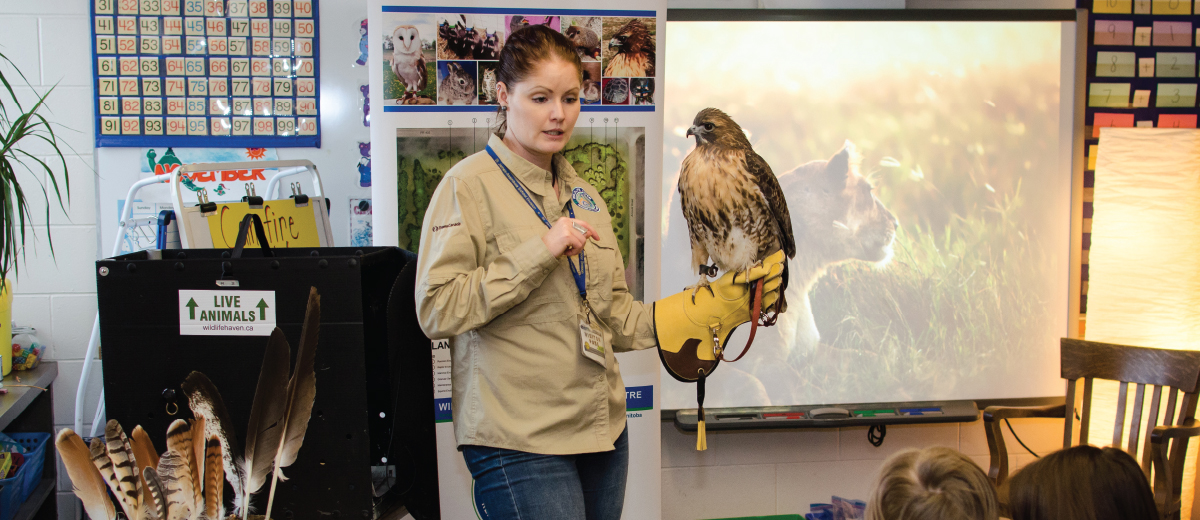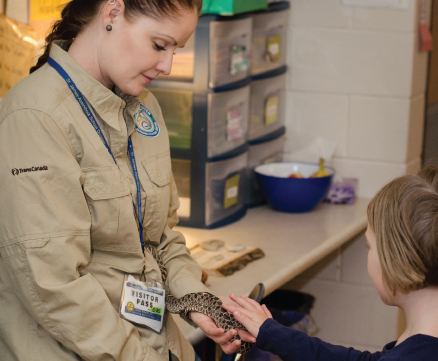
Photos & Story By Matea Tuhtar
A Grade 1-2 class at Crestview School had a hoot when two special guests in the form of a red-tailed hawk and great horned owl stopped by their classroom.
R2 and Max visited the school as Ambassadors from Wildlife Haven Rehabilitation Centre, sharing their stories about why they are not able to return to the wild and a lesson about how we can peacefully coexist with wildlife.
“The students have been talking about which birds fly south for the winter and which ones stay, and what happens if a bird is injured,” says teacher Erin Wilson. “That’s how Wildlife Haven came to be, because it’s a great opportunity for us to get some of those questions answered.”
The organization’s wildlife is ready to answer.
“We’ve always used ambassadors as the central focus of our education programs because the story that they tell really bring home the messages that we’re trying to offer people,” says Shauna Hewson, Education Program Coordinator at Wildlife Haven.
When students ask if they can pet Max the owl, Hewson talks about the biology of the bird and shows off its sharp talons and how powerful their beaks are. “Owls don’t want to be touched at all – they’re very sensitive and primate creatures so by us forcing touching on them, we’re actually causing them a lot of undue stress. So just little comments like ‘Can we pet the owl?’ can open up a very important discussion about why we shouldn’t be touching wildlife and feeding it or petting it.”

WILDLIFE HAVEN visits over 100 schools a year. The education program offers four different presentations as well as a build-your-own workshop where teachers can request customized material on themes such as wildlife ecology, wildlife rehabilitation, conservation, biodiversity, seasonal adaptations, habitat preservation.
Wildlife Haven started in 1984 by a group of concerned citizens who wanted to have a wildlife rehabilitation service in Manitoba. Located in Île-des-Chênes, the non–profit organization relies strictly on donations to keep its doors open. The three staff are aided by around 80 volunteers who help with all aspects of animal care.
Seventy per cent of the rescued animals are birds, including song birds, and the other 30 per cent are mammals and a few reptiles.
“Most of the mammals come into the facility as orphaned babies and include rabbits, squirrels, chipmunks, raccoons, foxes and coyotes,” says Hewson. And once in a while, a surprise animal shows up. In the fall of 2014 they received a phone call from someone in Middlebro, Manitoba claiming they had an orphaned bobcat.
“Normally when people call about this it turns out to be a very large house cat. But after a few days the man showed up to our facility carrying a real baby bobcat which had been orphaned on his property. That was our first bobcat and even as a baby it was aggressive to people.”
With an animal like the bobcat, Wildlife Haven worked with Manitoba Conservation to find an ideal place to release it into the wild, but with smaller animals the staff pick a place where they deem the animal has the best chances of survival. They just try not to release them close to people if they can help it.
And those who cannot return to the wild can gain a new purpose – all of the Wildlife Haven education ambassadors have a disability that makes it unsuitable for them to live in the wild.
“We refer to that disability as a story. And every story has a message about how people should treat wildlife or how human activity is affecting wildlife,” says Hewson.
Wildlife Haven visits over 100 schools a year, and a lot of teachers invite them back year after year. “There’s a lot of different topics we can talk about like conservation efforts, the urban environment and how it affects wildlife and even talking about wildlife as our neighbour is really effective,” says Hewson.
The education program offers four different presentations as well as a build-your-own workshop where teachers can request customized material on themes such as wildlife ecology, wildlife rehabilitation, conservation, biodiversity, seasonal adaptations, and habitat preservation.
“One of my favorites is a program called Frogs, Scales N’ RepTales that deal mostly with what I call the ‘under-appreciated wildlife’ – the cold and slippery things that not everyone likes to touch but that are actually very beautiful and very interesting and kids love to learn about them. In that one we talk about aquatic habitats, how different species survive a Manitoba winter, what kind of adaptations they have for survival,” says Hewson.
The education program offers four different presentations as well as a build-your-own workshop where teachers can request customized material on themes such as wildlife ecology, wildlife rehabilitation, conservation, biodiversity, seasonal adaptations, habitat preservation.
And sometimes the lessons extend beyond biology and ecology.
One of Hewson’s favorite memories was a presentation she did to a class where she talked about the ambassador animals’ disabilities in a way that increased their understanding of fellow classmates with disabilities.
“So it showed the students that while disabilities are often hard for people to deal with, it doesn’t mean that we should treat disabled people any differently.”
The presentations can be catered for any age of students, and there’s a new program that’s specifically targeted at teachers.
“Our new program is called Bringing Wildlife into your classroom and it focuses on partnering with teachers to develop nature-based learning content that can be customized to fit any school subject and classroom. Our aim is to offer a full-day workshop strictly for teachers where we help them develop classroom activities and projects that complement a wildlife visit, or complement what they are teaching in their curriculum.
“With our workshop we hope to give teachers fresh ideas on how to structure nature-based learning in their classroom through the whole school year. This workshop would ideally work for in-service days.”
Wilson, who attended a presentation by Wildlife Haven during MTS PD Day, says the class presentation was “a neat opportunity for students to see some local animals up close. We’ve been studying for a few weeks already so they were very excited for them to come. Their education programming tied in so well with what we’ve already been doing. The kids were engaged the whole time – they just loved it.”
To learn more about Wildlife Haven or book a presentation visit wildlifehaven.ca.
— This story was originally printed in the January/February 2017 issue of The Manitoba Teacher Magazine
